wheel INFINITI QX80 2015 Warranty Information Booklet
[x] Cancel search | Manufacturer: INFINITI, Model Year: 2015, Model line: QX80, Model: INFINITI QX80 2015Pages: 51, PDF Size: 1.36 MB
Page 36 of 51
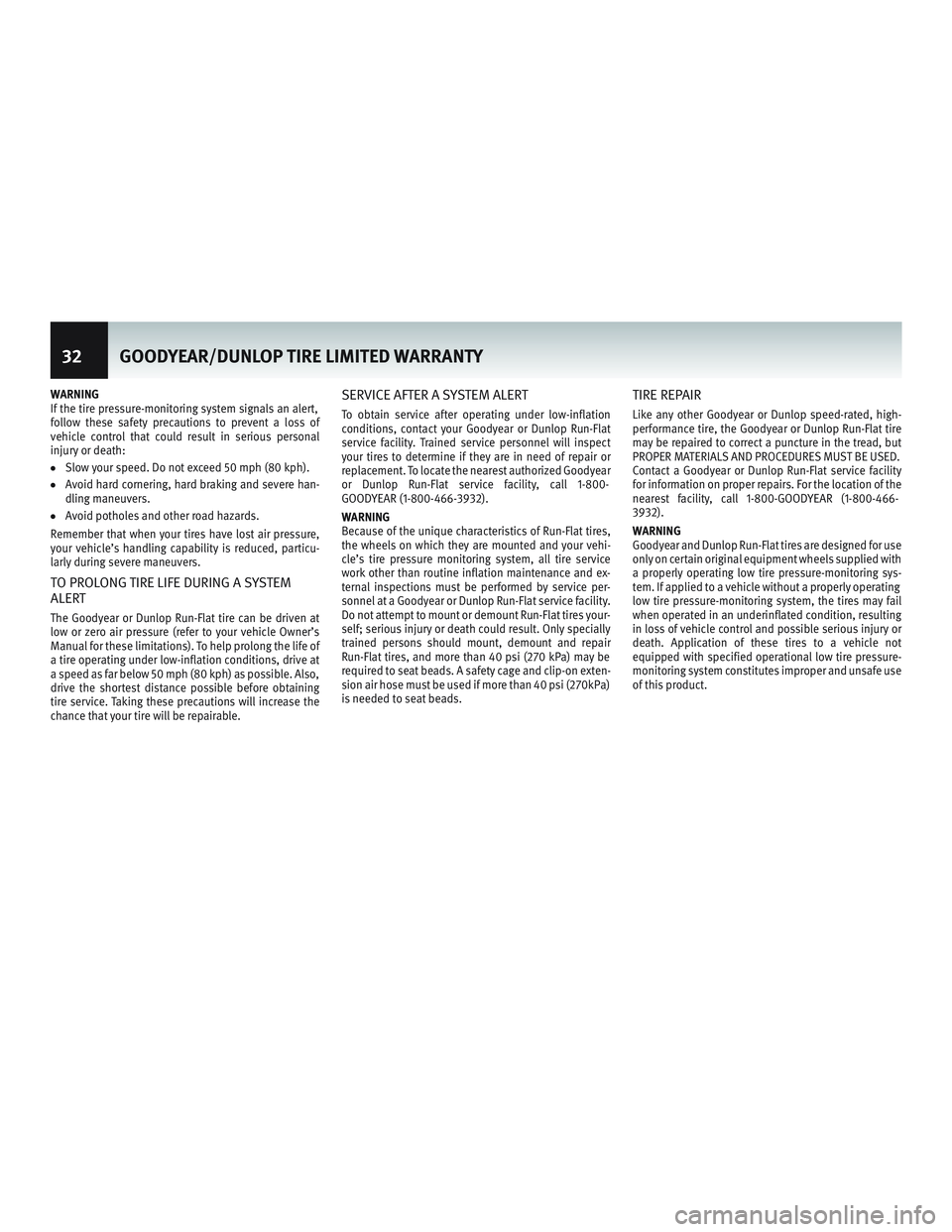
WARNING
If the tire pressure-monitoring system signals an alert,
follow these safety precautions to prevent a loss of
vehicle control that could result in serious personal
injury or death:
●Slow your speed. Do not exceed 50 mph (80 kph).
●Avoid hard cornering, hard braking and severe han-
dling maneuvers.
●Avoid potholes and other road hazards.
Remember that when your tires have lost air pressure,
your vehicle’s handling capability is reduced, particu-
larly during severe maneuvers.
TO PROLONG TIRE LIFE DURING A SYSTEM
ALERT
The Goodyear or Dunlop Run-Flat tire can be driven at
low or zero air pressure (refer to your vehicle Owner’s
Manual for these limitations). To help prolong the life of
a tire operating under low-inflation conditions, drive at
a speed as far below 50 mph (80 kph) as possible. Also,
drive the shortest distance possible before obtaining
tire service. Taking these precautions will increase the
chance that your tire will be repairable.
SERVICE AFTER A SYSTEM ALERT
To obtain service after operating under low-inflation
conditions, contact your Goodyear or Dunlop Run-Flat
service facility. Trained service personnel will inspect
your tires to determine if they are in need of repair or
replacement. To locate the nearest authorized Goodyear
or Dunlop Run-Flat service facility, call 1-800-
GOODYEAR (1-800-466-3932).
WARNING
Because of the unique characteristics of Run-Flat tires,
the wheels on which they are mounted and your vehi-
cle’s tire pressure monitoring system, all tire service
work other than routine inflation maintenance and ex-
ternal inspections must be performed by service per-
sonnel at a Goodyear or Dunlop Run-Flat service facility.
Do not attempt to mount or demount Run-Flat tires your-
self; serious injury or death could result. Only specially
trained persons should mount, demount and repair
Run-Flat tires, and more than 40 psi (270 kPa) may be
required to seat beads. A safety cage and clip-on exten-
sion air hose must be used if more than 40 psi (270kPa)
is needed to seat beads.
TIRE REPAIR
Like any other Goodyear or Dunlop speed-rated, high-
performance tire, the Goodyear or Dunlop Run-Flat tire
may be repaired to correct a puncture in the tread, but
PROPER MATERIALS AND PROCEDURES MUST BE USED.
Contact a Goodyear or Dunlop Run-Flat service facility
for information on proper repairs. For the location of the
nearest facility, call 1-800-GOODYEAR (1-800-466-
3932).
WARNING
Goodyear and Dunlop Run-Flat tires are designed for use
only on certain original equipment wheels supplied with
a properly operating low tire pressure-monitoring sys-
tem. If applied to a vehicle without a properly operating
low tire pressure-monitoring system, the tires may fail
when operated in an underinflated condition, resulting
in loss of vehicle control and possible serious injury or
death. Application of these tires to a vehicle not
equipped with specified operational low tire pressure-
monitoring system constitutes improper and unsafe use
of this product.
32 GOODYEAR/DUNLOP TIRE LIMITED WARRANTY
Page 37 of 51

WHO IS COVERED
The original owner of a MichelinPassenger orLight Truck
tire which bears the Michelin name and complete DOT
identification number.
WHAT IS COVERED AND FOR HOW LONG
Michelin Passenge r and Light Truck tires, used in normal
service on the vehicle on which they were originally
fitted and in accordance with the maintenance recom-
mendations and safety warnings contained in the Own-
er’s Manual and in the Important Tire Safety Informa-
tion Section of this booklet, are covered by this warranty
against defects in workmanship and material for the life
of the original usable tread, or 6 years from the date of
purchase, whichever comes first. At that time, all war-
ranties, express or implied, are terminated. The usable
tread is the original tread down to the level of the tread
wear indicators - 2/32nds of an inch (1.6mm) of tread
remaining. Date of purchase is documented by new
vehicle registration or tire sales invoice. If no proof of
purchase, coverage will be based on date of manufac-
ture.
WHAT IS NOT COVERED
Tires which become unserviceable due to:
●Road hazard injury (e.g., a cut, snag, bruise, impact
damage, puncture, whether repairable or not);
●Incorrect mounting of the tire, tire/wheel imbalance,
or improper repair;
●Underinfation, overinflation, improper maintenance
or other abuse;
●Mechanical irregularity in the vehicle such as wheel
misalignment resulting in uneven or rapid wear;
●Accident, fire, chemical corrosion, tire alteration, or
vandalism;
●Ozone or weather cracking.
WHAT MICHELIN WILL DO
PASSENGER AND LIGHT TRUCK TIRESA tire which becomes unserviceable due to a condition
covered by this warranty will be replaced with a compa-
rable new Michelin tire, free of charge, when 2/32nds of
an inch (1.6mm) or less of the original tread is worn, (or
25% or less, whichever is most beneficial to the user) and
within 12 months of the date of purchase. Mounting and
balancing of tires is included. The cost of any other service
charges or applicable taxes are payable by the user.
When more than 2/32nds of an inch of original tread
has been worn (or more than 25%, whichever is most
beneficial to the user) or after 12 months from date of
purchase, the user must pay the cost of a comparable
new Michelin passenger or light truck replacement tire
on a pro-rata b asis.The retailer shall determine the
charge by multiplying the percentage of the original
usable tread worn by the current actual selling price at
the adjustment location or the price on the current Mi-
chelin Base Price List, whichever is lower. This List is
based on a predetermined price intended to fairly rep-
resent the actual selling price of the tire. The cost of
mounting, balancing and any other service charges or
applicable taxes are payable by the user.
WHAT THE CONSUMER MUST DO
When making a claim under the terms of this warranty,
the consumer must present the tire to an authorized
Michelin Retailer. To locate an Authorized Tire Retailer,
check the yellow pages under “Tire Retailers - Retail.” The vehicle on which the tire was used should be avail-
able for inspection.
It is essential that you read and understand the safety
and maintenance recommendations (see Safety Main-
tenance Information) for your tires.
CONDITIONS AND EXCLUSIONS
THIS WARRANTY DOES NOT PROVIDE COMPENSATION
FOR LOSS OF TIME, LOSS OF USE OF VEHICLE, INCONVE-
NIENCE OR CONSEQUENTIAL DAMAGE. TIRES PRE-
SENTED FOR CLAIM REMAIN THE PROPERTY OF THE CON-
SUMER AND MICHELIN ACCEPTS NO RESPONSIBILITY
FOR LOSS OF, OR DAMAGE TO, TIRES WHICH ARE IN THE
CUSTODY OR CONTROL OF A MICHELIN TIRE RETAILER
FOR THE PURPOSES OF
INSPECTION FOR WARRANTY
ADJUSTMENT. IN THE EVENT OF A DISPUTED CLAIM, THE
CONSUMER MUST MAKE THE TIRE AVAILABLE FOR FUR-
THER INSPECTION.
NO MICHELIN REPRESENTATIVE, EMPLOYEE OR RE-
TAILER HAS THE AUTHORITY TO MAKE OR IMPLY ANY
REPRESENTATION, PROMISE OR AGREEMENT, WHICH
IN ANY WAY VARIES THE TERMS OF THIS WARRANTY.
THIS WARRANTY APPLIES ONLY IN THE UNITED STATES
AND CANADA.
CONSUMER RIGHTS
THIS WARRANTY GIVES YOU SPECIFIC LEGAL RIGHTS,
AND YOU MAY ALSO HAVE OTHER RIGHTS WHICH VARY
FROM STATE TO STATE AND PROVINCE TO PROVINCE.
(Continued on next page)
MICHELIN PASSENGER AND LIGHT TRUCK TIRE LIMITED WARRANTY 33
Page 40 of 51
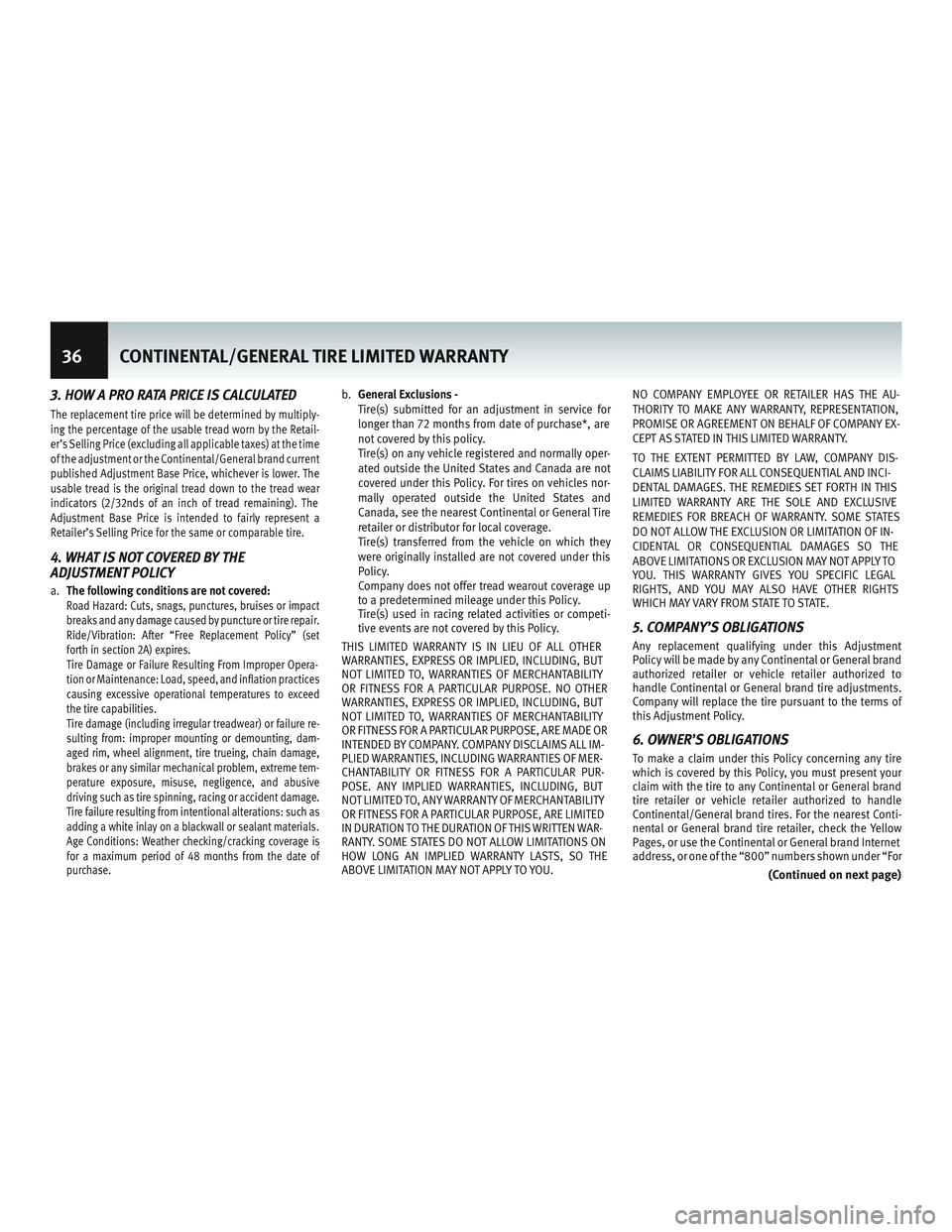
3. HOW A PRO RATA PRICE IS CALCULATED
The replacement tire price will be determined by multiply-
ing the percentage of the usable tread worn by the Retail-
er’s Selling Price (excluding all applicable taxes) at the time
of the adjustment or the Continental/General brand current
published Adjustment Base Price, whichever is lower. The
usable tread is the original tread down to the tread wear
indicators (2/32nds of an inch of tread remaining). The
Adjustment Base Price is intended to fairly represent a
Retailer’s Selling Price for the same or comparable tire.
4. WHAT IS NOT COVERED BY THE
ADJUSTMENT POLICY
a.The following conditions are not covered:Road Hazard: Cuts, snags, punctures, bruises or impact
breaks and any damage caused by puncture or tire repair.
Ride/Vibration: After “Free Replacement Policy” (set
forth in section 2A) expires.
Tire Damage or Failure Resu lting From Improper Opera-
tion or Maintenance: Load, speed, and inflation practices
causing excessive operational temperatures to exceed
the tire capabilities.
Tire damage (including irregular treadwear) or failure re-
sulting from: improper mounting or demounting, dam-
aged rim, wheel alignment, tire trueing, chain damage,
brakes or any similar mechanical problem, extreme tem-
perature exposure, misuse, negligence, and abusive
driving such as tire spinning, racing or accident damage.
Tire failure resulting from intentional alterations: such as
adding a white inlay on a black wall or sealant materials.
Age Conditions: Weather checking/cracking coverage is
for a maximum period of 48 months from the date of
purchase.
b. General Exclusions -
Tire(s) submitted for an adjustment in service for
longer than 72 months from date of purchase*, are
not covered by this policy.
Tire(s) on any vehicle registered and normally oper-
ated outside the United States and Canada are not
covered under this Policy. For tires on vehicles nor-
mally operated outside the United States and
Canada, see the nearest Continental or General Tire
retailer or distributor for local coverage.
Tire(s) transferred from the vehicle on which they
were originally installed are not covered under this
Policy.
Company does not offer tr ead wearout coverage up
to a predetermined mileage under this Policy.
Tire(s) used in racing related activities or competi-
tive events are not covered by this Policy.
THIS LIMITED WARRANTY IS IN LIEU OF ALL OTHER
WARRANTIES, EXPRESS OR IMPLIED, INCLUDING, BUT
NOT LIMITED TO, WARRANTIES OF MERCHANTABILITY
OR FITNESS FOR A PARTICULAR PURPOSE. NO OTHER
WARRANTIES, EXPRESS OR IMPLIED, INCLUDING, BUT
NOT LIMITED TO, WARRANTIES OF MERCHANTABILITY
OR FITNESS FOR A PARTICULAR PURPOSE, ARE MADE OR
INTENDED BY COMPANY. COMPANY DISCLAIMS ALL IM-
PLIED WARRANTIES, INCLUDING WARRANTIES OF MER-
CHANTABILITY OR FITNESS FOR A PARTICULAR PUR-
POSE. ANY IMPLIED WARRANTIES, INCLUDING, BUT
NOT LIMITED TO, ANY WARRANTY OF MERCHANTABILITY
OR FITNESS FOR A PARTICULAR PURPOSE, ARE LIMITED
IN DURATION TO THE DURATION OF THIS WRITTEN WAR-
RANTY. SOME STATES DO NOT ALLOW LIMITATIONS ON
HOW LONG AN IMPLIED WARRANTY LASTS, SO THE
ABOVE LIMITATION MAY NOT APPLY TO YOU. NO COMPANY EMPLOYEE OR RETAILER HAS THE AU-
THORITY TO MAKE ANY WARRANTY, REPRESENTATION,
PROMISE OR AGREEMENT ON BEHALF OF COMPANY EX-
CEPT AS STATED IN THIS LIMITED WARRANTY.
TO THE EXTENT PERMITTED BY LAW, COMPANY DIS-
CLAIMS LIABILITY FOR ALL CONSEQUENTIAL AND INCI-
DENTAL DAMAGES. THE REMEDIES SET FORTH IN THIS
LIMITED WARRANTY ARE THE SOLE AND EXCLUSIVE
REMEDIES FOR BREACH OF WARRANTY. SOME STATES
DO NOT ALLOW THE EXCLUSION OR LIMITATION OF IN-
CIDENTAL OR CONSEQUENTIAL DAMAGES SO THE
ABOVE LIMITATIONS OR EXCLUSION MAY NOT APPLY TO
YOU. THIS WARRANTY GIVES YOU SPECIFIC LEGAL
RIGHTS, AND YOU MAY ALSO HAVE OTHER RIGHTS
WHICH MAY VARY FROM STATE TO STATE.
5. COMPANY’S OBLIGATIONS
Any replacement qualifying under this Adjustment
Policy will be made by any Continental or General brand
authorized retailer or vehicle retailer authorized to
handle Continental or General brand tire adjustments.
Company will replace the tire pursuant to the terms of
this Adjustment Policy.
6. OWNER’S OBLIGATIONS
To make a claim under this Policy concerning any tire
which is covered by this Policy, you must present your
claim with the tire to any Continental or General brand
tire retailer or vehicle retailer authorized to handle
Continental/General brand tires. For the nearest Conti-
nental or General brand tire retailer, check the Yellow
Pages, or use the Continental or General brand Internet
address, or one of the “800” numbers shown under “For
(Continued on next page)
36
CONTINENTAL/GENERAL TIRE LIMITED WARRANTY
Page 42 of 51
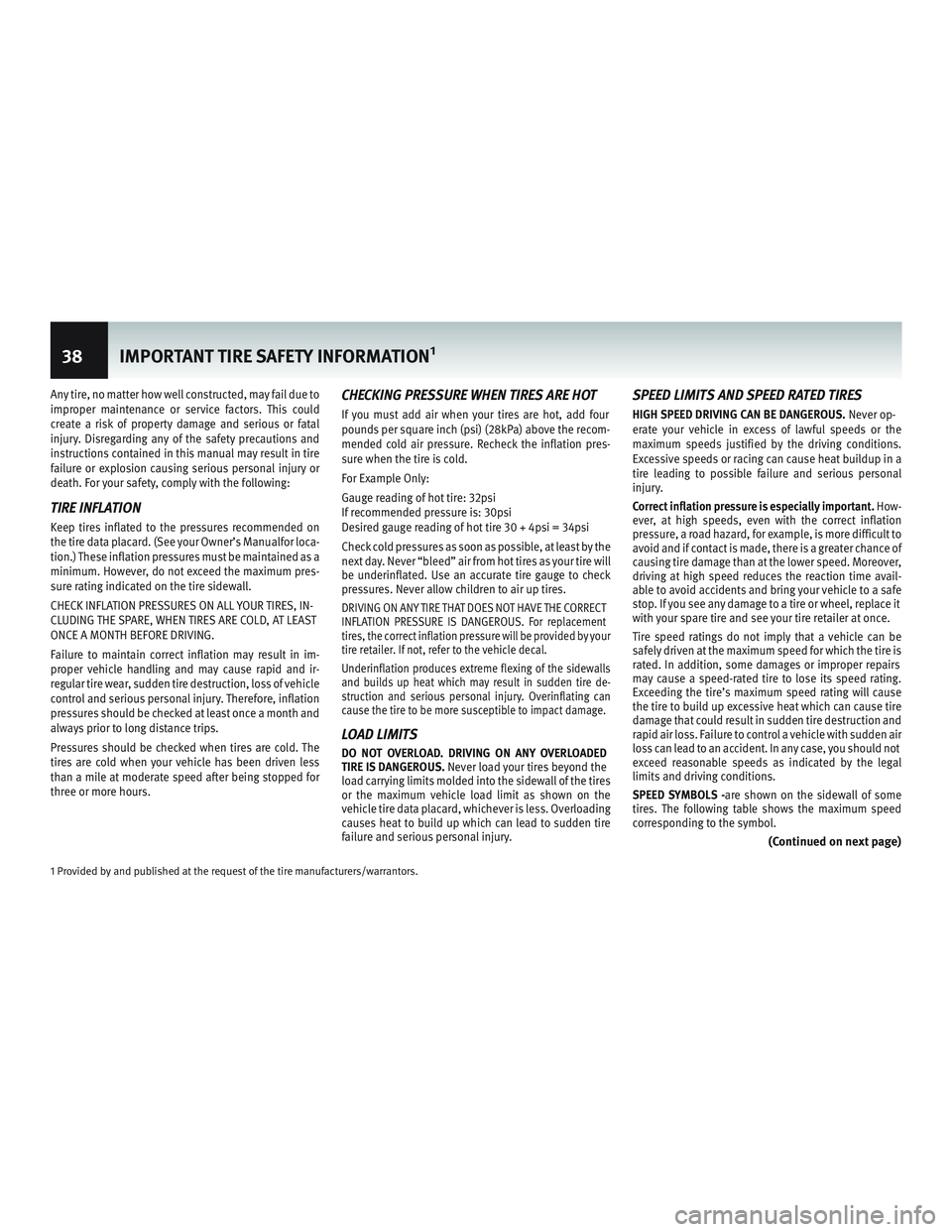
Any tire, no matter how well constructed, may fail due to
improper maintenance or service factors. This could
create a risk of property damage and serious or fatal
injury. Disregarding any of the safety precautions and
instructions contained in this m anual may result in tire
failure or explosion caus ing serious personal injury or
death. For your safety, comply with the following:
TIRE INFLATION
Keep tires inflated to the pressures recommended on
the tire data placard. (See your Owner’s Manualfor loca-
tion.) These inflation pressures must be maintained as a
minimum. However, do not exceed the maximum pres-
sure rating indicated on the tire sidewall.
CHECK INFLATION PRESSURES ON ALL YOUR TIRES, IN-
CLUDING THE SPARE, WHEN TIRES ARE COLD, AT LEAST
ONCE A MONTH BEFORE DRIVING.
Failure to maintain correct inflation may result in im-
proper vehicle handling and may cause rapid and ir-
regular tire wear, sudden tire destruction, loss of vehicle
control and serious personal injury. Therefore, inflation
pressures should be checked at least once a month and
always prior to long distance trips.
Pressures should be checked when tires are cold. The
tires are cold when your vehicle has been driven less
than a mile at moderate speed after being stopped for
three or more hours.
CHECKING PRESS URE WHEN TIRES ARE HOT
If you must add air when your tires are hot, add four
pounds per square inch (psi) (28kPa) above the recom-
mended cold air pressure. Recheck the inflation pres-
sure when the tire is cold.
For Example Only:
Gauge reading of hot tire: 32psi
If recommended pressure is: 30psi
Desired gauge reading of hot tire 30 + 4psi = 34psi
Check cold pressures as soon as possible, at least by the
next day. Never “bleed” air from hot tires as your tire will
be underinflated. Use an accurate tire gauge to check
pressures. Never allow children to air up tires.
DRIVING ON ANY TIRE THAT DOES NOT HAVE THE CORRECT
INFLATION PRESSURE IS DANGEROUS. For replacement
tires, the correct inflation pressure will be provided by your
tire retailer. If not, refer to the vehicle decal.
Underinflation produces extreme flexing of the sidewalls
and builds up heat which may result in sudden tire de-
struction and serious personal injury. Overinflating can
cause the tire to be more susceptible to impact damage.
LOAD LIMITS
DO NOT OVERLOAD. DRIVING ON ANY OVERLOADED
TIRE IS DANGEROUS. Never load your tires beyond the
load carrying limits molded into the sidewall of the tires
or the maximum vehicle load limit as shown on the
vehicle tire data placard, whichever is less. Overloading
causes heat to build up which can lead to sudden tire
failure and serious personal injury.
SPEED LIMITS AND SPEED RATED TIRES
HIGH SPEED DRIVING CAN BE DANGEROUS. Never op-
erate your vehicle in excess of lawful speeds or the
maximum speeds justified by the driving conditions.
Excessive speeds or racing can cause heat buildup in a
tire leading to possible f ailure and serious personal
injury.
Correct inflation pressure is especially important. How-
ever, at high speeds, ev en with the correct inflation
pressure, a road hazard, for example, is more difficult to
avoid and if contact is made, there is a greater chance of
causing tire damage than at the lower speed. Moreover,
driving at high speed reduces the reaction time avail-
able to avoid accidents and bring your vehicle to a safe
stop. If you see any damage to a tire or wheel, replace it
with your spare tire and see your tire retailer at once.
Tire speed ratings do not imply that a vehicle can be
safely driven at the maximum speed for which the tire is
rated. In addition, some damages or improper repairs
may cause a speed-rated tire to lose its speed rating.
Exceeding the tire’s maximum speed rating will cause
the tire to build up excessive heat which can cause tire
damage that could result in sudden tire destruction and
rapid air loss. Failure to control a vehicle with sudden air
loss can lead to an accident. In any case, you should not
exceed reasonable speeds as indicated by the legal
limits and driving conditions.
SPEED SYMBOLS -are shown on the sidewall of some
tires. The following table shows the maximum speed
corresponding to the symbol.
(Continued on next page)
1 Provided by and published at the request of the tire manufacturers/warrantors.
38IMPORTANT TIRE SAFETY INFORMATION1
Page 43 of 51
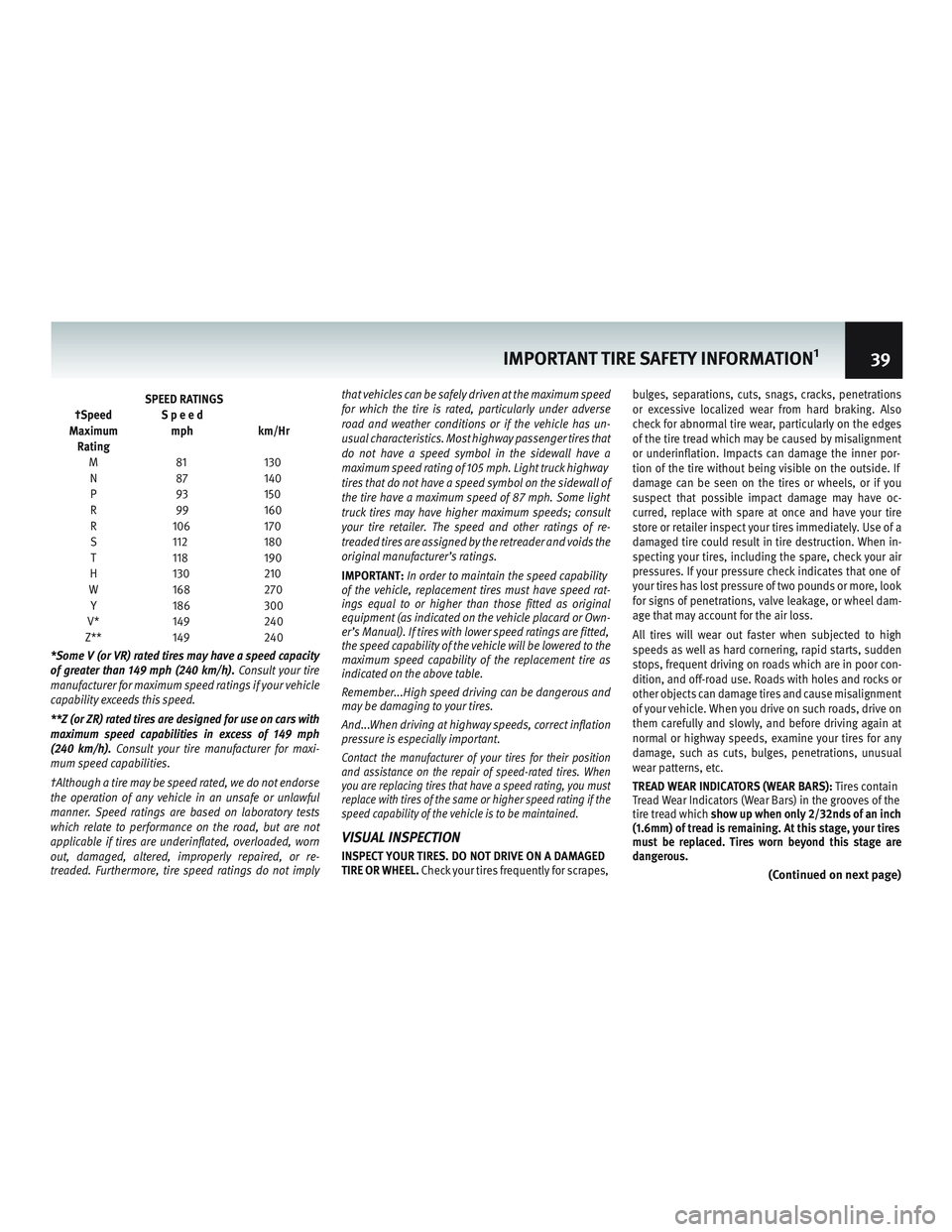
SPEED RATINGS
†Speed S peed
Maximum Rating mph km/Hr
M 81 130 N 87 140P 93 150
R 99 160
R 106 170
S 112 180 T 118 190
H 130 210
W 168 270 Y 186 300
V* 149 240
Z** 149 240
*Some V (or VR) rated tires may have a speed capacity
of greater than 149 mph (240 km/h). Consult your tire
manufacturer for maximum speed ratings if your vehicle
capability exceeds this speed.
**Z (or ZR) rated tires are designed for use on cars with
maximum speed capabilities in excess of 149 mph
(240 km/h). Consult your tire manufacturer for maxi-
mum speed capabilities.
†Although a tire may be speed rated, we do not endorse
the operation of any vehicle in an unsafe or unlawful
manner. Speed ratings are based on laboratory tests
which relate to performance on the road, but are not
applicable if tires are underinflated, overloaded, worn
out, damaged, altered, improperly repaired, or re-
treaded. Furthermore, tire speed ratings do not imply that vehicles can be safely driven at the maximum speed
for which the tire is rated, particularly under adverse
road and weather conditions or if the vehicle has un-
usual characteristics. Most highway passenger tires that
do not have a speed symbol in the sidewall have a
maximum speed rating of 105 mph. Light truck highway
tires that do not have a speed symbol on the sidewall of
the tire have a maximum speed of 87 mph. Some light
truck tires may have higher maximum speeds; consult
your tire retailer. The speed and other ratings of re-
treaded tires are assigned by the retreader and voids the
original manufacturer’s ratings.
IMPORTANT:
In order to maintain the speed capability
of the vehicle, replacement tires must have speed rat-
ings equal to or higher than those fitted as original
equipment (as indicated on the vehicle placard or Own-
er’s Manual). If tires with lower speed ratings are fitted,
the speed capability of the vehicle will be lowered to the
maximum speed capability of the replacement tire as
indicated on the above table.
Remember...High speed driving can be dangerous and
may be damaging to your tires.
And...When driving at highway speeds, correct inflation
pressure is especially important.
Contact the manufacturer of your tires for their position
and assistance on the repair of speed-rated tires. When
you are replacing tires that have a speed rating, you must
replace with tires of the same or higher speed rating if the
speed capability of the vehicle is to be maintained.
VISUAL INSPECTION
INSPECT YOUR TIRES. DO NOT DRIVE ON A DAMAGED
TIRE OR WHEEL. Check your tires frequently for scrapes, bulges, separations, cuts, snags, cracks, penetrations
or excessive localized wear from hard braking. Also
check for abnormal tire wear, particularly on the edges
of the tire tread which may be caused by misalignment
or underinflation. Impacts can damage the inner por-
tion of the tire without being
visible onthe outside. If
damage can be seen on the tires or wheels, or if you
suspect that possible impact damage may have oc-
curred, replace with spare at once and have your tire
store or retailer inspect your tires immediately. Use of a
damaged tire could result in tire destruction. When in-
specting your tires, including the spare, check your air
pressures. If your pressure check indicates that one of
your tires has lost pressure of two pounds or more, look
for signs of penetrations, valve leakage, or wheel dam-
age that may account for the air loss.
All tires will wear out faster when subjected to high
speeds as well as hard cornering, rapid starts, sudden
stops, frequent driving on roads which are in poor con-
dition, and off-road use. Roads with holes and rocks or
other objects can damage tires and cause misalignment
of your vehicle. When you drive on such roads, drive on
them carefully and slowly, and before driving again at
normal or highway speeds, examine your tires for any
damage, such as cuts, bulges, penetrations, unusual
wear patterns, etc.
TREAD WEAR INDICATORS (WEAR BARS): Tires contain
Tread Wear Indicators (Wear Bars) in the grooves of the
tire tread which show up when only 2/32nds of an inch
(1.6mm) of tread is remaining. At this stage, your tires
must be replaced. Tires worn beyond this stage are
dangerous.
(Continued on next page)
IMPORTANT TIRE SAFETY INFORMATION139
Page 44 of 51
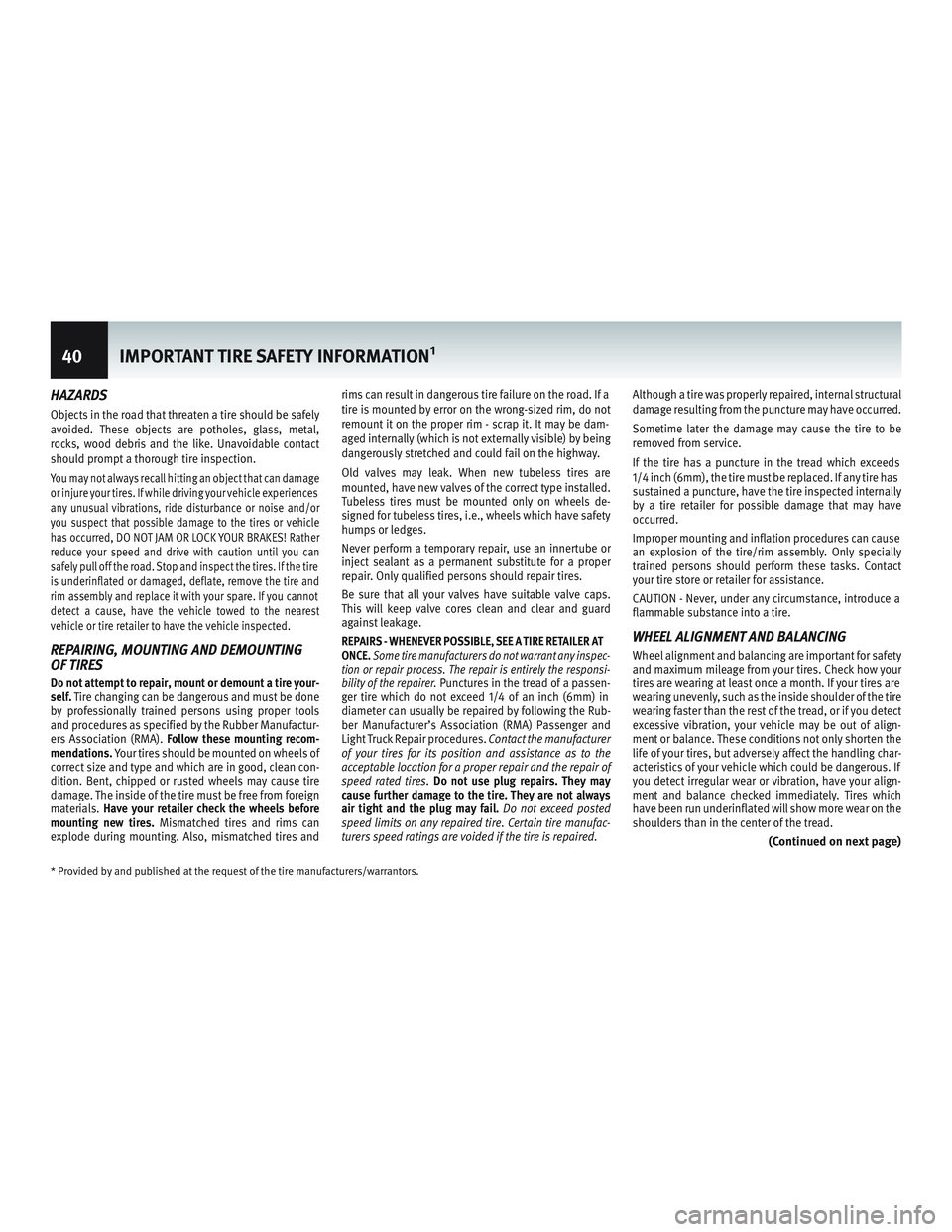
HAZARDS
Objects in the road that threaten a tire should be safely
avoided. These objects arepotholes, glass,metal,
rocks, wood debris and the like. Unavoidable contact
should prompt a thorough tire inspection.
You may not always recall hitting an object that can damage
or injure your tires. If while driving your vehicle experiences
any unusual vibrations, ride disturbance or noise and/or
you suspect that possible damage to the tires or vehicle
has occurred, DO NOT JAM OR LOCK YOUR BRAKES! Rather
reduce your speed and drive with caution until you can
safely pull off the road. Stop and inspect the tires. If the tire
is underinflated or damaged, deflate, remove the tire and
rim assembly and replace it with your spare. If you cannot
detect a cause, have the vehicle towed to the nearest
vehicle or tire retailer to have the vehicle inspected.
REPAIRING, MOUNTING AND DEMOUNTING
OF TIRES
Do not attempt to repair, mount or demount a tire your-
self. Tire changing can be dangerous and must be done
by professionally trained persons using proper tools
and procedures as specified by the Rubber Manufactur-
ers Association (RMA). Follow these mounting recom-
mendations. Your tires should be mounted on wheels of
correct size and type and which are in good, clean con-
dition. Bent, chipped or rusted wheels may cause tire
damage. The inside of the tire must be free from foreign
materials. Have your retailer check the wheels before
mounting new tires. Mismatched tires and rims can
explode during mounting. Also, mismatched tires and rims can result in dangerous tire failure on the road. If a
tire is mounted by error on the wrong-sized rim, do not
remount it on the proper rim - scrap it. It may be dam-
aged internal
ly (which is not extern ally visible) by being
dangerously stretched and could fail on the highway.
Old valves may leak. When new tubeless tires are
mounted, have new valves of the correct type installed.
Tubeless tires must be mounted only on wheels de-
signed for tubeless tires, i.e., wheels which have safety
humps or ledges.
Never perform a temporary repair, use an innertube or
inject sealant as a permanent substitute for a proper
repair. Only qualified persons should repair tires.
Be sure that all your valves have suitable valve caps.
This will keep valve cores clean and clear and guard
against leakage.
REPAIRS - WHENEVER POSSIBLE, SEE A TIRE RETAILER AT
ONCE. Some tire manufacturers do not warrant any inspec-
tion or repair process. The repair is entirely the responsi-
bility of the repairer.
Punctures in the tread of a passen-
ger tire which do not exceed 1/4 of an inch (6mm) in
diameter can usually be repaired by following the Rub-
ber Manufacturer’s Association (RMA)Passenger and
Light Truck Repair procedures. Contact the manufacturer
of your tires for its position and assistance as to the
acceptable location for a proper repair and the repair of
speed rated tires. Do not use plug repairs. They may
cause further damage to the tire. They are not always
air tight and the plug may fail. Do not exceed posted
speed limits on any repaired tire. Certain tire manufac-
turers speed ratings are voided if the tire is repaired. Although a tire was properly repaired, internal structural
damage resulting from the puncture may have occurred.
Sometime later the damage may cause the tire to be
removed from service.
If the tire has a puncture in the tread which exceeds
1/4 inch (6mm), the tire must be replaced. If any tire has
sustained a puncture, have the tire inspected internally
by a tire retailer for possible damage that may have
occurred.
Improper mounting and inflation procedures can cause
an explosion of the tire/rim assembly. Only specially
trained persons should perform these tasks. Contact
your tire store or retailer for assistance.
CAUTION - Never, under any c
ircumstance, introduce a
flammable substance into a tire.
WHEEL ALIGNMENT AND BALANCING
Wheel alignment and balancing are important for safety
and maximum mileage from your tires. Check how your
tires are wearing at least once a month. If your tires are
wearing unevenly, such as the inside shoulder of the tire
wearing faster than the rest of the tread, or if you detect
excessive vibration, your vehicle may be out of align-
ment or balance. These conditions not only shorten the
life of your tires, but adversely affect the handling char-
acteristics of your vehicle which could be dangerous. If
you detect irregular wear or vibration, have your align-
ment and balance checked immediately. Tires which
have been run underinflated will show more wear on the
shoulders than in the center of the tread.
(Continued on next page)
* Provided by and published at the request of the tire manufacturers/warrantors.
40IMPORTANT TIRE SAFETY INFORMATION1
Page 45 of 51
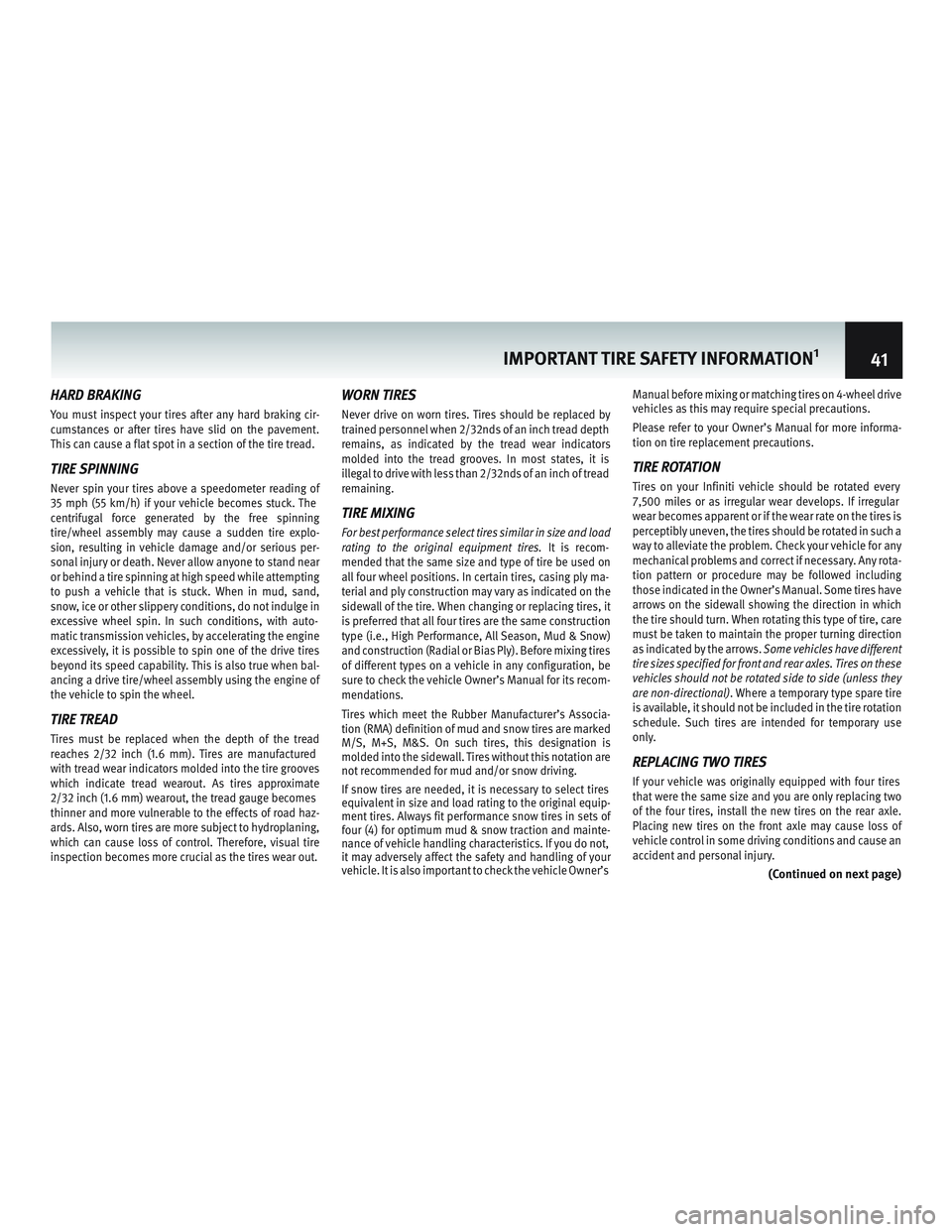
HARD BRAKING
You must inspect your tires after any hard braking cir-
cumstances or after tires have slid on the pavement.
This can cause a flat spot in a section of the tire tread.
TIRE SPINNING
Never spin your tires above a speedometer reading of
35 mph (55 km/h) if your vehicle becomes stuck. The
centrifugal force generated by the free spinning
tire/wheel assembly may cau se a sudden tire explo-
sion, resulting in vehicle damage and/or serious per-
sonal injury or death. Never allow anyone to stand near
or behind a tire spinning at high speed while attempting
to push a vehicle that is stuck. When in mud, sand,
snow, ice or other slippery conditions, do not indulge in
excessive wheel spin. In such conditions, with auto-
matic tran smission vehicles , by accelerating the engine
excessively, it is possible to spin one of the drive tires
beyond its speed capability. This is also true when bal-
ancing a drive tire/wheel assembly using the engine of
the vehicle to spin the wheel.
TIRE TREAD
Tires must be replaced when the depth of the tread
reaches 2/32 inch (1.6 mm). Tires are manufactured
with tread wear indicators molded into the tire grooves
which indicate tread wearout. As tires approximate
2/32 inch (1.6 mm) wearout, the tread gauge becomes
thinner and more vulnerable to the effects of road haz-
ards. Also, worn tires are more subject to hydroplaning,
which can cause loss of control. Therefore, visual tire
inspection becomes more crucial as the tires wear out.
WORN TIRES
Never drive on worn tires. Tires should be replaced by
trained personnel when 2/32nds of an inch tread depth
remains, as indicated by the tread wear indicators
molded into the tread grooves. In most states, it is
illegal to drive with less than 2/32nds of an inch of tread
remaining.
TIRE MIXING
For best performance select tires similar in size and load
rating to the original equipment tires. It is recom-
mended that the same size and type of tire be used on
all four wheel positions. In certain tires, casing ply ma-
terial and ply construction may vary as indicated on the
sidewall of the tire. When changing or replacing tires, it
is preferred that all four tires are the same construction
type (i.e., High Performance, All Season, Mud & Snow)
and construction (Radial or Bias Ply). Before mixing tires
of different types on a vehicle in any configuration, be
sure to check the vehicle Owner’s Manual for its recom-
mendations.
Tires which meet the Rubber Manufacturer’s Associa-
tion (RMA) definition of mud and snow tires are marked
M/S, M+S, M&S. On such tires, this designation is
molded into the sidewall. Tires without this notation are
not recommended for mud and/or snow driving.
If snow tires are needed, it is necessary to select tires
equivalent in size and load rating to the original equip-
ment tires. Always fit performance snow tires in sets of
four (4) for optimum mud & snow traction and mainte-
nance of vehicle handling characteristics. If you do not,
it may adversely affect the safety and handling of your
vehicle. It is also important to check the vehicle Owner’s Manual before mixing or matching tires on 4-wheel drive
vehicles as this may require special precautions.
Please refer to your Owner’s Manual for more informa-
tion on tire replacement precautions.
TIRE ROTATION
Tires on your Infiniti vehicle should be rotated every
7,500 miles or as irregular wear develops. If irregular
wear becomes apparent or if the wear rate on the tires is
perceptibly uneven, the tires should be rotated in such a
way to alleviate the problem. Check your vehicle for any
mechanical problems and correct if necessary. Any rota-
tion pattern or procedure may be followed including
those indicated in the Owner’s Manual. Some tires have
arrows on the sidewall showing the direction in which
the tire should turn. When rotating this type of tire, care
must be taken to maintain the proper turning direction
as indicated by the arrows.
Some vehicles have different
tire sizes specified for front and rear axles. Tires on these
vehicles should not be rotated side to side (unless they
are non-directional) . Where a temporary type spare tire
is available, it should not be included in the tire rotation
schedule. Such tires are intended for temporary use
only.
REPLACING TWO TIRES
If your vehicle was originally equipped with four tires
that were the same size and you are only replacing two
of the four tires, install the new tires on the rear axle.
Placing new tires on the front axle may cause loss of
vehicle control in some driving conditions and cause an
accident and personal injury.
(Continued on next page)
IMPORTANT TIRE SAFETY INFORMATION141
Page 46 of 51
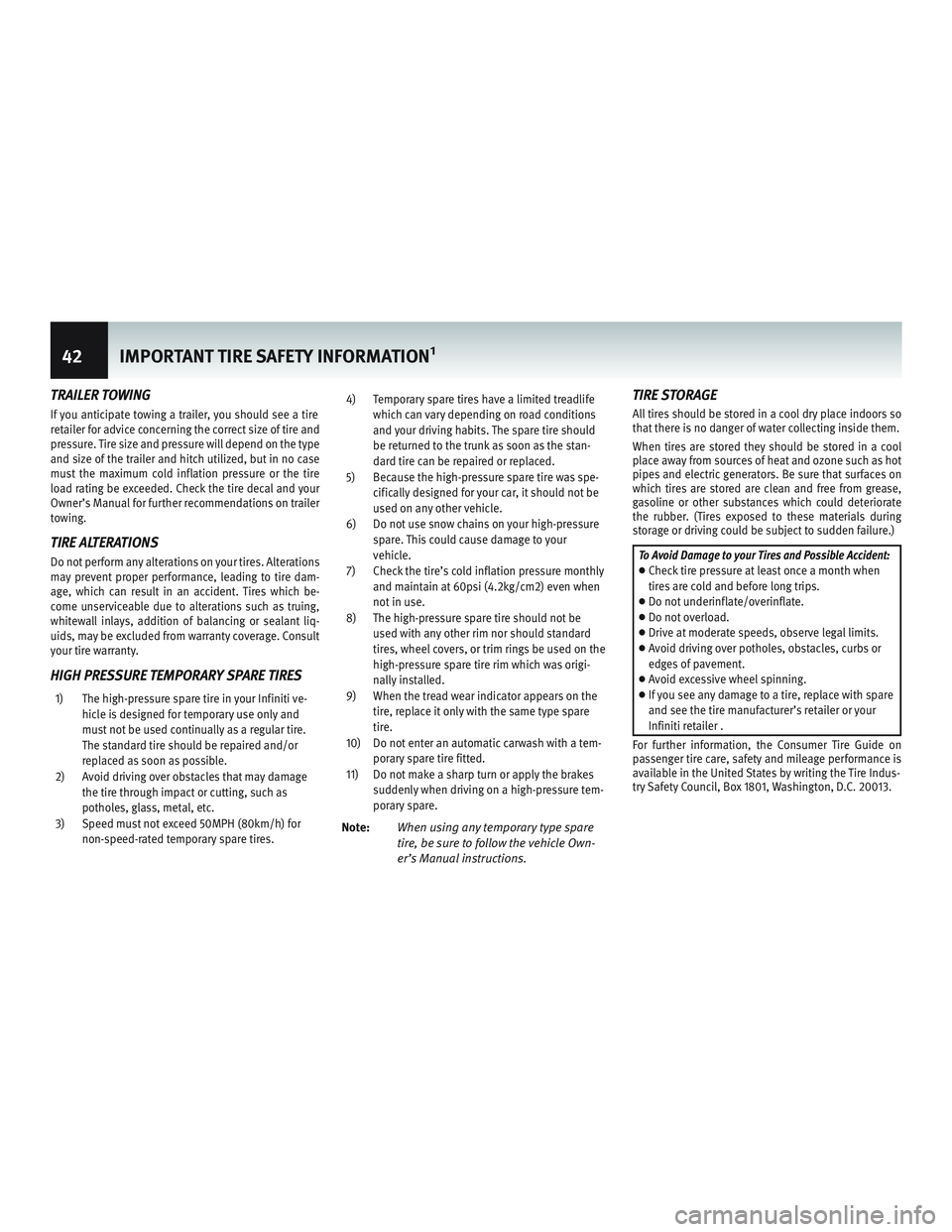
TRAILER TOWING
If you anticipate towing a trailer, you should see a tire
retailer for advice concerning the correct size of tire and
pressure. Tire size and pressure will depend on the type
and size of the trailer and hitch utilized, but in no case
must the maximum cold inflation pressure or the tire
load rating be exceeded. Check the tire decal and your
Owner’s Manual for further recommendations on trailer
towing.
TIRE ALTERATIONS
Do not perform any alterations on your tires. Alterations
may prevent proper performance, leading to tire dam-
age, which can result in an accident. Tires which be-
come unserviceable due to alterations such as truing,
whitewall inlays, addition of balancing or sealant liq-
uids, may be excluded from warranty coverage. Consult
your tire warranty.
HIGH PRESS URE TEMPORARY SPARE TIRES
1) The high-pressure spare tire in your Infiniti ve-
hicle is designed for temporary use only and
must not be used continually as a regular tire.
The standard tire should be repaired and/or
replaced as soon as possible.
2) Avoid driving over obstacles that may damage the tire through impact or cutting, such as
potholes, g lass,metal, etc.
3) Speed must not exceed 50MPH (80km/h) for non-speed-rated temporary spare tires. 4) Temporary spare tires have a limited treadlife
which can vary depending on road conditions
and your driving habits. The spare tire should
be returned to the trunk as soon as the stan-
dard tire can be repaired or replaced.
5) Because the high-pressure spare tire was spe- cifically designed for your car, it should not be
used on any other vehicle.
6) Do not use snow chains on your high-pressure spare. This could cause damage to your
vehicle.
7) Check the tire’s cold inflation pressure monthly and maintain at 60psi (4.2kg/cm2) even when
not in use.
8) The high-pressure spare tire should not be used with any other rim nor should standard
tires, wheel covers, or trim rings be used on the
high-pressure spare tire rim which was origi-
nally installed.
9) When the tread wear indicator appears on the tire, replace it only with the same type spare
tire.
10) Do not enter an automatic carwash with a tem- porary spare tire fitted.
11) Do not make a sharp turn or apply the brakes suddenly when driving on a high-pressure tem-
porary spare.
Note: When using any temporary type spare
tire, be sure to follow the vehicle Own-
er’s Manual instructions.
TIRE STORAGE
All tires should be stored in a cool dry place indoors so
that there is no danger of water collecting inside them.
When tires are stored they should be stored in a cool
place away from sources of heat and ozone such as hot
pipes and electric generators. Be sure that surfaces on
which tires are stored are clean and free from grease,
gasoline or other substances which could deteriorate
the rubber. (Tires exposed to these materials during
storage or driving could be subject to sudden failure.)
To Avoid Damage to your Tires and Possible Accident:● Check tire pressure at least once a month when
tires are cold and before long trips.
● Do not underinflate/overinflate.
● Do not overload.
● Drive at moderate speeds, observe legal limits.
● Avoid driving over potholes, obstacles, curbs or
edges of pavement.
● Avoid excessive wheel spinning.
● If you see any damage to a tire, replace with spare
and see the tire manufacturer’s retailer or your
Infiniti retailer .
For further information, the Consumer Tire Guide on
passenger tire care, safety and mileage performance is
available in the United States by writing the Tire Indus-
try Safety Council, Box 1801, Washington, D.C. 20013.
42 IMPORTANT TIRE SAFETY INFORMATION1
Page 49 of 51
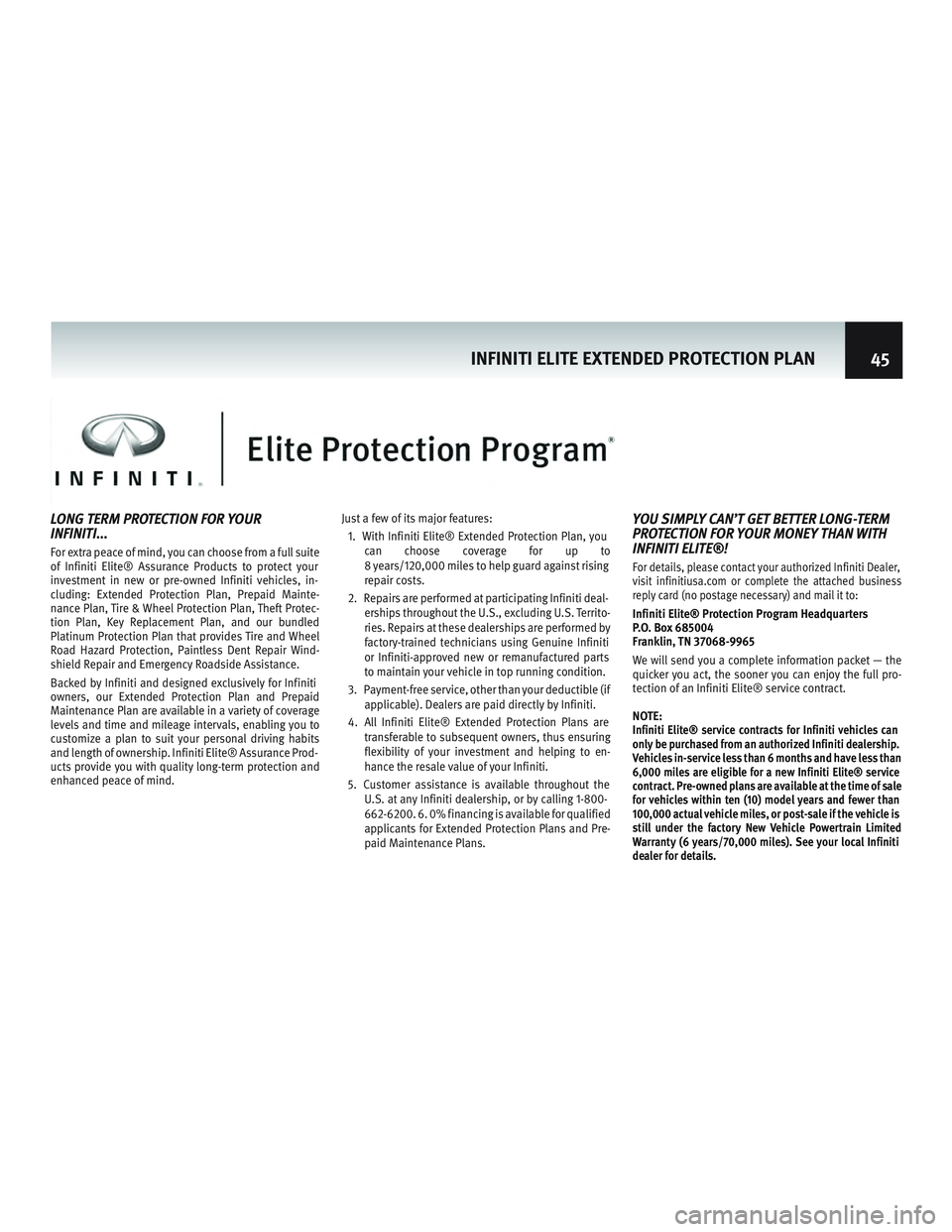
LONG TERM PROTECTION FOR YOUR
INFINITI...
For extra peace of mind, you can choose from a full suite
of Infiniti Elite® Assurance Products to protect your
investment in new or pre-owned Infiniti vehicles, in-
cluding: Extended ProtectionPlan, Prepaid Mainte-
nance Plan, Tire & Wheel Protection Plan, Theft Protec-
tion Plan, Key Replacement Plan, and our bundled
Platinum Protection Plan that provides Tire and Wheel
Road Hazard Protection, Paintless Dent Repair Wind-
shield Repair and Emer gency RoadsideAssistance.
Backed by Infiniti and designed exclusively for Infiniti
owners, our Extended Prot ection Plan and Prepaid
Maintenance Plan are available in a variety of coverage
levels and time and mileage intervals, enabling you to
customize a plan to suit your personal driving habits
and length of ownership. Infiniti Elite® Assurance Prod-
ucts provide you with quality long-term protection and
enhanced peace of mind. Just a few of its major features:
1. With Infiniti Elite® Extended Protection Plan, you canchoosecoverageforupto
8 years/120,000 miles to help guard against rising
repair costs.
2. Repairs are performed at participating Infiniti deal- erships throughout the U.S., ex cluding U.S. Territo-
ries. Repairs at these dealerships are performed by
factory-trained technicians using Genuine Infiniti
or Infiniti-approved new or remanufactured parts
to maintain your vehicle in top running condition.
3. Payment-free service, other than your deductible (if applicable). Dealer s are paid directly by Infiniti.
4. All Infiniti Elite® Extended Protection Plans are transferable to subsequent owners, thus ensuring
flexibility of your investment and helping to en-
hance the resale value of your Infiniti.
5. Customer assistance is available throughout the
U.S. at any Infiniti dealer ship, or by calling 1-800-
662-6200. 6. 0% financing is available for qualified
applicants for Extended Pr otection Plans and Pre-
paid Maintenance Plans.
YOU SIMPLY CAN’T GET BETTER LONG-TERM
PROTECTION FOR YOUR MONEY THAN WITH
INFINITI ELITE®!
For details, please contact your authorized Infiniti Dealer,
visit infinitiusa.com or complete the attached business
reply card (no postage necessary) and mail it to:
Infiniti Elite® Protection Program Headquarters
P.O. Box 685004
Franklin, TN 37068-9965
We will send you a complete information packet — the
quicker you act, the sooner you can enjoy the full pro-
tection of an Infiniti Elite® service contract.
NOTE:
Infiniti Elite® service contracts for Infiniti vehicles can
only be purchased from an authorized Infiniti dealership.
Vehicles in-service less than 6 months and have less than
6,000 miles are eligible for a new Infiniti Elite® service
contract. Pre-owned plans are available at the time of sale
for vehicles within ten (10) model years and fewer than
100,000 actual vehicle miles, or post-sale if the vehicle is
still under the factory New Vehicle Powertrain Limited
Warranty (6 years/70,000 miles). See your local Infiniti
dealer for details.
INFINITI ELITE EXTENDED PROTECTION PLAN 45